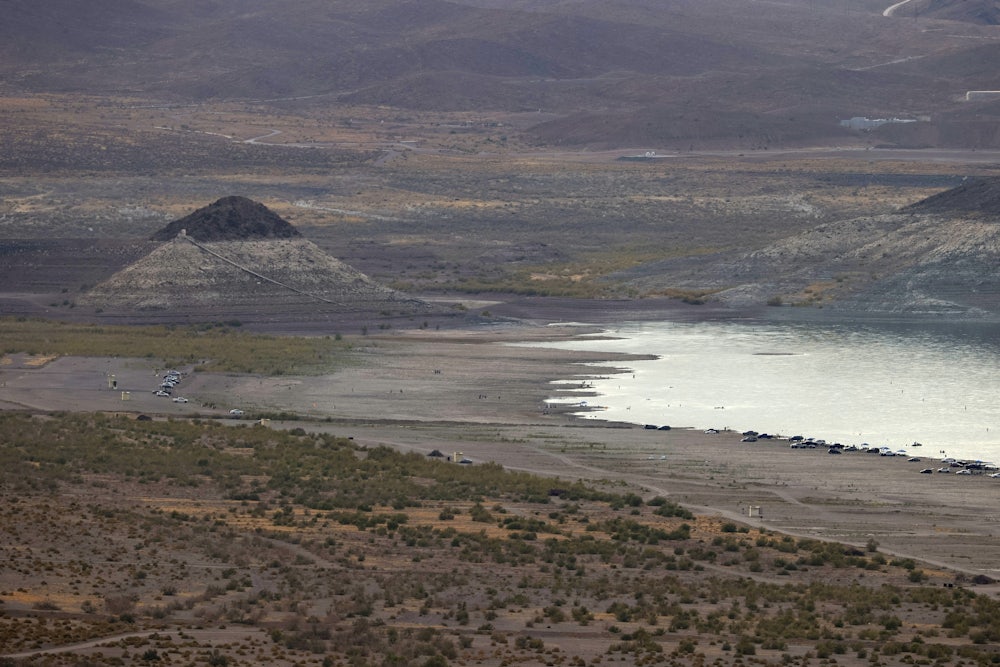Last week was a difficult one in the American West, a region now facing three overlapping climate crises: a megadrought rounding the corner into its third decade, a record-setting heat wave, and an outbreak of wildfires. There might have been no better encapsulation of the moment than an anecdote offered on Wednesday by John Truett, an Arizona state fire management officer. Truett and his team were prepared to jump into action to snuff out the active Telegraph and Mescal fires burning through eastern Arizona. But when they went to San Carlos Lake to scoop water from the lake to douse the flames with, Truett realized there was no water to scoop. According to local outlet Arizona’s Family, San Carlos Lake, which can hold up to 19,500 acre-feet of water, is currently clinging on to just 50 acre-feet. The water levels are too low for his team’s planes to collect, Truett told officials in the state Capitol, meaning they now have to make a longer trip to other lakes and reservoirs—precious minutes when one is trying to tame concurrent wildfires.
This is terrifying information to hear from a public official simply trying to do his job, particularly when that job is putting out fires large enough to risk the continued existence of entire communities. It is also precisely the sort of situation that climate scientists have been predicting for the West since it became clear, a decade ago, that the region’s drought status wasn’t simply going to solved by a heavy monsoon or snowpack season. Daily and monthly record temperature highs were recorded across the region last week, the number of new wildfires stand at a 10-year peak, and farmers in several states are soon set to have their water supplies significantly reduced or fully cut off to save what little remains for critical use. What officials like Truett are now tasked with is finding a series of temporary solutions and fixes to stave off the absolute worst-case outcomes—even if those salves won’t be enough.
One immediate option being explored by tribal, state, and federal water and infrastructure officials in the West is a series of dam-removal projects, starting with the Snake River dams in Idaho and the Klamath River dams in Oregon and California. Many of the dams that block the free flow of rivers across the Midwest and West were built and installed by the Army Corps of Engineers in the early to mid-twentieth century, at a time when the American federal government was intent on whittling down the land claims of sovereign tribal nations. Indigenous communities were routinely displaced and almost never consulted on the placement of these projects. Their subsequent construction also led to the disruption of many fishing-based economies, with the dams blocking the travel patterns of freshwater fish like salmon and steelhead.
Last Thursday, the Federal Energy Regulatory Commission approved a license transfer for the lower-basin hydroelectric dams that will allow the state governments of Oregon and California, as well as the Klamath River Renewal Corporation—a nonprofit entity consisting of local, state, and tribal-appointed officials—to assume control over the dams. As ActiveNorCal pointed out last week, the environmental and economic cases to ditch the Klamath dams are strong ones, given that the dams provide no irrigation or drinking-water benefits and their current upkeep costs outweigh the hydroelectricity production they provide. (The movement is, however, facing intense opposition by local far-right, Bundy-adjacent activists and politicians bandying anti-Indigenous rhetoric, as exhaustively outlined two weeks ago by the Institute for Research and Education on Human Rights.)
Allowing water to flow freely throughout the West is an excellent first step, especially as it relates to granting tribal nations a say over what happens to their lands and waterways. But the hard truth of the drought is that the flow in many of those rivers—most prominently the Colorado River, which has been rapidly, and sadly, reduced to a ghost of itself—will still not be high enough to sustain the communities, industries, and nations that depend on them. It was for this reason that the states along the Colorado River basin concocted a series of water compacts, designed to help the myriad governments decide how to fairly allocate the Colorado’s remaining flow. There are triggers baked into the compacts, designed to dictate when certain states and groups have to cut their overall water usage. These triggers are based around the water levels at reservoirs like Lake Mead and Lake Powell, which, as I have previously reported, are hemorrhaging their existing supplies.
Colorado Public Radio reported on Friday that the number everyone is looking at for Lake Powell—which collects waters from the upper-basin entities (Colorado, New Mexico, Utah, and Wyoming) and disperses it to lower-basin entities (Arizona, California, Nevada, and Mexico)—is 3,525 feet. Once the water dips below that marker, the upper-basin states, as well the Bureau of Reclamation, will be responsible for diverting more water to Lake Powell. As of Sunday, Lake Powell’s elevation rested at 3,561 feet.
Officials in both the lower and upper basins are desperately hoping to avoid diverting water, as that would make the existing political tensions, already fraying in the heat, even worse. A seven-state litigation battle could ensue over who is owed water from the river. Amy Ostdiek, who serves as the deputy chief of the federal, interstate, and water information section of the Colorado Water Conservation Board, warned that any legal efforts would likely result in “a very long, drawn out process,” which, as Truett underscored, will only work against the best interest of an expeditious response.
The somewhat dismal truth is that these are ultimately just temporary solutions. The answer as to what needs to happen—what must happen lest this aberration become the norm for the entire continent and globe—is clear. The United States, along with the world’s other nations, needs to stop pumping carbon emissions into the atmosphere immediately. And public officials like the West’s climate-denying Senate Republicans or coal disciples like Democrat Joe Manchin need to do a ride-along with Truett, or at the very least have their water cut off for a few days to understand that what they view as a regional crisis is in fact a harbinger of their children and grandchildren’s future. (Last week, as people in the West braced against the worst of the climate crisis, Manchin cashed in on a speaking fee at Edison Electric Institute’s annual conference, where he complained that the Biden administration’s relatively tepid climate approach was setting a “very aggressive timetable.”)
This is not a problem that can be simply boiled down to blaming the coal, gas, and oil industries and their congressional lackeys, however. Recapping the trying week in Sunday’s Los Angeles Times, reporter Sammy Roth wrote that the “the invisible hand of climate change is hard at work here.” The problem is, too few media outlets are framing the West’s current water, heat, and wildfire issues—or the South’s growing hurricane problem, or the Midwest’s increasingly frequent floods—within the broader issue of an emissions-driven climate crisis. Last week, Chase Woodruff, a reporter for Colorado Newsline, compiled the media coverage of the drought by fellow local outlets in the Centennial State, analyzing whether these articles reported on the heat waves and wildfires in the context of the human-induced effects of the climate crisis. Of the 126 stories Woodruff reviewed, only five “make even the slightest reference to climate change.”
There is no magic wand to wave to bring a monthlong monsoon pouring down upon the West, just as there’s no storm surge wall that can be constructed to wholly resist coastal erosion from hurricanes. What needs to happen, and soon, is for people everywhere to understand that the life-upending natural disasters once reserved for every other decade are now seasonal facts of life because of what humans have pumped into this planet’s atmosphere. If a hard line can be drawn between the drilling fields in New Mexico and Wyoming and the fires raging in people’s backyards, and public officials can be either pushed out of office or pushed to act accordingly, then maybe there’s a chance that these drought contingency plans will work as they were intended. If not, then observing record highs and even drier lakes will become a morbid annual tradition.








